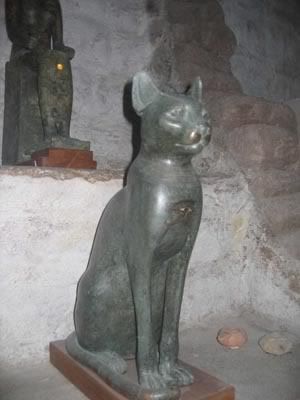
[Above - Cat statue representing Bastet from the Field Museum, Chicago, Illinois. This cat is shown wearing a menet collar, and has a wadjet eye on its chest and a scarab on its forehead. It also has banded markings in its fur on the tail. Photo supplied by John V. DeWerd.]
The cat in ancient Egypt was called the "miw"; they were called this simply because the "meow" is the sound a cat makes when interacting with humans, as well as this being the sound kittens make to their mother. Unlike many other animals in ancient Egypt, cats were hardly ever given names, and seem to have just been referred to as "miw" (cat). This is unusual, considering that people were often named after animals themselves, including the cat; for example, one name that became popular for people to be named was "Pa-Miu" (the tomcat). These cats were depicted with plain coats, tabby stripes, or with spots. Scenes of cats in the Middle Kingdom are usually represented in bird hunting depictions that take place in a papyrus skiff or thicket. Cats in these types of settings appear to have taken over Old Kingdom versions; whereby an Egyptian mongoose or genet had been depicted out on a hunt in earlier times instead of the cat. When cats began to replace them in these scenes they are shown usually balancing precariously on one or two papyrus stalks or umbels with a prized bird in its jaws or in its claws. It is unknown, with any certainty, if these cats at this time were domesticated, tamed, or still wild, by looking at the scenes alone, but it is often assumed that, because they are helpful in bird hunting, in that they disturb the birds from the papyrus marshes making it easier for the hunter to hit the bird with his throwstick, they were likely at least tamed animals, if not fully domesticated.
The earliest evidence of fully domesticated cats comes from the banquet scenes, which became more popular during the New Kingdom. These often show a deceased couple seated beside each other with stacks of food being offered to them in the afterlife. Beneath the chairs of the couple, things were often placed what they would like to take with them to the afterlife; this often included animals that were obviously beloved pets, like monkeys, dogs, birds, and cats (the earliest example of this type of scene is now currently in the Petrie Museum, London, England). You can be sure that these animals depicted beneath chairs were indeed family pets, as they were sometimes even shown with leashes around their necks or with a bowl of food beside them. Also, anyone that has owned a small animal will know that they just love to sit beneath their master's chair, so this is a very accurate representation of the actions of a pet. Traditionally, certain animals in ancient Egypt were owned by a specific sex; women tended to be shown with gazelles, birds, and cats, whereas men were shown more with dogs and monkeys, although there is a very touching scene with a cat sitting beneath her owner's seat (that of a lady), whilst her kitten is playing on the knee of the of the man sitting beside the lady. This scene can be viewed in the tomb of the craftsman, Ipuy, at Theban Tomb 217 from the reign of Ramessu (II). When cats were first kept as pets -either as a family pet, or a village companion - it would most likely have been with the knowledge that cats would protect homes, villages, and grain stores, from mice, rats, and snakes. This led to a mutually beneficial relationship developing between human and cat, and as domestication of cats increased, the size of the wild cat's body and muscle tone reduced because of change in diet and activity, as well as their coats becoming more colourful because of camouflage for survival no-longer being necessary. In ancient Egypt, cats were regarded as sacred; even the moisture on the cat's nose was seen as holy!
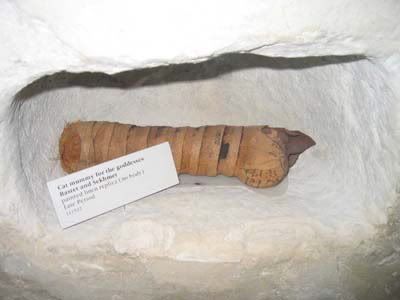
[Above - Mummified cat from the Late Period, taken at the Field Museum, Chicago, Illinois. Only the head of a cat was actually wrapped in this case; the rest is just stuffing. Photo supplied by John V. DeWerd.]
Cats were also mummified in ancient Egypt. This could be for two very different reasons. The first cause for a cat to be mummified was so that a beloved pet could reach the afterlife, just like its human counterparts. An example of this is shown by the beautiful limestone sarcophagus that Prince Djehutymose (son of Amenhotep III and elder brother of Amenhotep IV/Akhenaton) had made for his she-cat after her death (now in the Cairo Museum, Egypt). The text on the sarcophagus refers to the cat as "Usir (Osiris), she-cat" and along the left and right side of the box the cat sitting in front of a table of offerings is depicted; behind the cat on the right-hand side, there even stands what could be a feline-headed ushabti, so that this precious cat will be free from labour in the afterlife, or more likely, just an image of the she-cat herself. The great historian, Herodotus, says that in his lifetime (the Late Period of ancient Egypt), if a house were to catch fire, people would only be concerned about saving their cats and not their property. Also, according to Herodotus, if, and when, a family cat were to die, the tradition of the distraught owners was to shave off their eyebrows in mourning and take the cat to Per-Bast (Bubastis), the home of the cat goddess named Bastet, to be buried. The owner of the deceased cat often left items with the buried animal for their pet to play with in the afterlife, as well as little bowls of milk to keep them nourished. Cat mummification consisted of removing the organs and stuffing the body out with sand or other packing materials. The body is then arranged into the sitting position and wrapped tightly, and then finally the facial features and body markings are painted onto the mummy wrappings and the body is left to naturally dehydrate. Ancient Egyptian royalty took their feline ownership a step further by often having a tamed lion as a pet! The remains of seven lion cubs were discovered around Hor-Aha's Abedju (Abydos) tomb (from the first dynasty), and the first mummified remains of a lion were found a few years ago belonging to the wet-nurse of Tutankhamun, Maia (from the eighteenth dynasty). But, by far the most famous lion that was kept as a pet was the lion belonging to Ramessu (II), whom he named "Slayer of his Foes." This lion was often depicted as accompanyig the pharaoh into battle; ready to pounce on Ramessu's (II) enemies. During the reign of Ramessu (IV), the hunting of lions was forbidden during feast days of the goddess Bastet; at any other time lion hunting was viewed as a virile sport that proved that a pharaoh was worthy of his crowns if he brought back slain lions. However, the above mention of cats in ancient Egypt by Herodotus was not unique amongst foreigners that liked to note the importance of the cat to the ancient Egyptians. Another Greek historian, Plutarch, said that a cat will first have one kitten, then two kittens, next three kittens, and so on until they have a litter of seven kittens, by which time they have had twenty-eight kittens altogether; this comment he made was in reference to their fertility, and it was observed that this was the same number as the amount of days in the lunar month. Also, the Macedonian author, Polyaenus, gave an account of the battle of Pelusium, which occurred in 525 BC in the eastern Nile Delta. He wrote that one of the things that Cambyses (II), Persian ruler, did to gain an advantage in the battle against the Egyptians was to line up lots of animals, including cats, at the front of their army to shield themselves from the Egyptian military in their opposition. The Egyptians were so worried that they would harm the beloved animals that their cautiousness led them to loose the battle. These instances show that the cat was highly thought of by many Egyptians, and mummifying them on their death was a way of the humans expressing their gratitude and displaying their adoration for these animals.
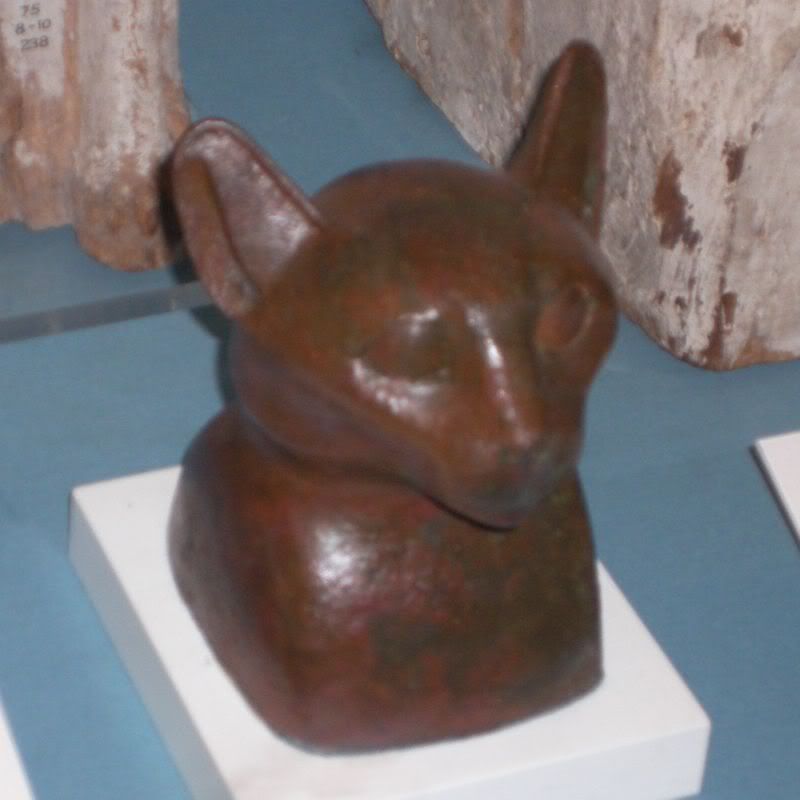
[Above - A bronze mask for a mummified cat from the Ptolemaic Period. At the British Museum, London, England.]
Another reason for cats being mummified in ancient Egypt was as an offering to a deity. All animals, including cats, were not considered to be gods themselves, only that gods could sometimes choose to show themselves to humans through the bodies of animals; examples of deities sometimes choosing a feline guise include Aset (Isis), Hut-Hor (Hathor), and the god Maahes, who was considered the son of the cat-headed goddess Bastet in Lower Egypt, but also he was thought of as the son of the lioness-headed goddess Sekhmet in Upper Egypt. Certain animals became symbolic of particular gods whom possessed similar characteristics to their chosen animal, and one of the most popular type of animal to become associated with the gods was the feline. The idea of gods manifesting themselves as certain domestic animals developed wildly in the Egyptian Late Period, which led to - especially in Ptolemaic times - pilgrims leaving offerings of mummified animals to the gods, in hopes that their prayers would be answered. Because the offering of symbolic animals was so hugely popular during this time, cats became attached to temples and were bred in catteries to represent the feline deity associated with that temple, but in most cases the fate of these bred cats was not particularly good, as they were simply killed to be mummified and sold to pilgrims to offer to the deity. In keeping with the mummification methods of humans during this period, the outer appearance of the mummified cat was more important than what was going on inside the wrappings. X-rays of mummified cats have shown that these bred cats only lived to be a year old at the most - often only living for a few months - and were killed by twisting their necks or strangling them; this is revealed by the displaced vertebrae that show up in the X-rays. Evidence has even exposed that some of these cats were killed from a sharp blow to the head. Investigations into mummified votive cats have also shown that these mummified cats did not always contain a whole animal, as often limbs etcetera were missing, so it would seem that these mummies were put together rushed without much consideration to the potential buyers; it was a big money business, so it would have been far more important that the mummies were available in large quantities, rather than them needing to be expertly produced. Besides, so long as the outer wrappings resembled a cat in shape and style, none of the pilgrims would have been any wiser that everything was not present inside the mummy.
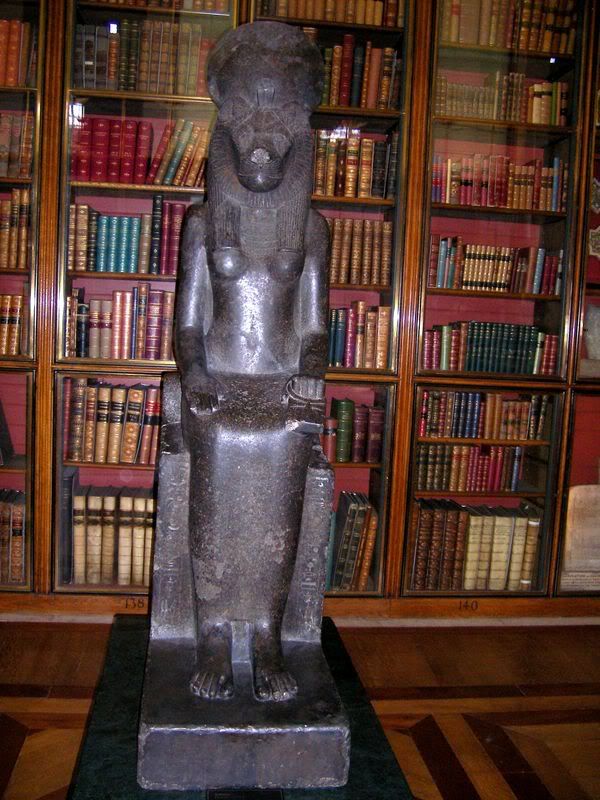
[Right - Statue of Sekhmet, 1370 BC. This is one of a possible seven-hundred and thirty such granite statues of Sekhmet erected by Amenhotep (III) at his mortuary temple. In half of these statues Sekhmet was rendered seated and in the other half she was shown standing; a pair, one seated and one standing, is believed to represent each day of the year. So far, almost six-hundred of these statues have been found. Photo taken at the British Museum, London, England.]
Felines were very prominent in Egyptian religion, with many mentions of felines in religious texts and lots of different deities taking the form of various felines at one time or another. Some examples of felines in texts, and gods depicted as felines, are noted here. Mafdet, the panther goddess (or possibly a cheetah or leopard), was mentioned in the Pyramid Texts as springing on the neck of the serpent. Her name meant "the runner" and she was prayed to for defence against snakebites and scorpion stings, so her role as protector of the pharaoh against the snakes of the Underworld in these texts fits in nicely with her characteristics. In the seventh hour of the Imyduat (The Book of that which is in the Underworld), a cat-headed being decapitates enemies before Usir (Osiris) who is protected by the snake, Mehen; more feline-headed deities appear in this text in hours one, two, four, and ten, and in the eleventh hour there are eight lion-headed aspects of the goddess Sekhmet. A cat-headed creature named Miuty is named in the Book of the Gates as one of the guardians to the eleventh gate that the sun-god must pass through; the gateway is called "Mysterious of Approaches," and Miuty holds a serpent sceptre in one hand and a was sceptre in the other. More feline deities, including Miuty, appear in the Enigmatic Book of the Underworld; a unique example can be found on the second shrine of Tutankhamun. In the Book of the Caverns a cat-headed god binds the enemies of the sun-god, and in the Litany of Ra texts a mummiform feline-headed deity is depicted as well as a seated cat as aspects of the sun-god. The god, Ra, is depicted as the great cat of Iunu (Heliopolis) in the texts known as The Book of Coming Forth by Day (more commonly known as The Book of the Dead) sitting beside the ished tree (same as the Greek Persea tree), whilst defeating the snake-demon, Apep (Apophis), by brandishing a knife. Feline-headed deities also appear in the line-up of forty-two judges in the weighing of the heart spell from The Book of Coming Forth by Day, as well as a double-headed guardian (a lion-headed goddess with a crocodile head emerging from the back of her neck), called Hetepethor, sometimes being present in these texts. In these examples, the cat always seems to be viewed in a positive light. Both the goddess, Neith, and the goddess, Tefnut, have a lioness-headed aspect, as does Mut, whom had a sandstone seated cat statue dedicated to her at her precinct in the Karnak Temple; this was discovered in 1979 by the Brooklyn Museum Expedition. But by far the most popular feline deities were Bastet, Sekhmet, and Pakhet. During dynasty twenty-three to twenty-four, the Libyan rulers brought the worship of Bastet to prominence by making Per-Bast (Bubastis) their royal city and building temples in her honour there. At this time Bastet grew from a local goddess to a state deity, and with that her depictions evolved from her being generally shown as a human goddess with the head of a cat, to her being mostly represented as a cat sitting on its haunches with its tail curled around its feet. Sometimes Bastet, when depicted as a cat-headed woman, was shown carrying a basket in which to hold her kittens; this represents her associations with motherhood and fertility. A cat cemetery was unearthed at Per Bast by Edouard Naville, which contained thousands of mummified cats, as well as possibly the ashes of cremated cats. The goddess Sekhmet was considered a more ferocious aspect of Bastet, but was worshipped in her own right. When Amenemhat (I) moved the capital from Waset (Thebes) to Itjtawy in the Fayoum, the cult centre of Sekhmet moved there as well, and in Taremu (Leontopolis) tamed lions were kept in temples dedicated to the goddess. Sekhmet was depicted in artwork as a lion or lion-headed woman, and had cat cemeteries dedicated to herself and Bastet at Saqqara. Pakhet, another lion-headed goddess, was probably seen as a mixture of Bastet and Sekhmet; her temperament being somewhere in between the tender traits of Bastet and the wild nature of Sekhmet. Not only was Pakhet depicted as a lion-headed woman, but also as a feline killing snakes with her claws. Pakhet had two temples dedicated to her at Speos Artemidos ("Cave of Artemis" in Greek) and has catacombs containing mummified cats devoted to her.
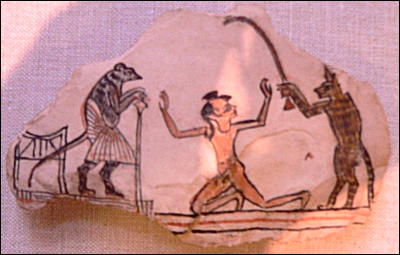
[Above - New Kingdom, nineteenth or twentieth dynasty, Limestone Ostracan from the Oriental Institute, Chicago, Illinois. Pigment on recto depicts a man being judged by a mouse and punished by a cat; the drawing was first sketched in red ink, then was outlined in black ink, and finally coloured in. On the verso is the inscription "Cat and mouse bring the bad boy to court" in hieratics. Photo supplied by Bob Manske.]
Not only were felines mentioned in religious texts in ancient Egypt, but they also found themselves in other texts and artwork as well. An ancient Egyptian text containing dream interpretation describes the outcome of seeing a large cat in one's dreams; this is referred to as a good omen because it is said to mean that a large harvest will come to the dreamer. Depictions of cats are also found in humorous scenes on ostraca and papyrus; these often include role reversal type situations. In one such example, ducks are being herded by a cat that walks upright on its hind paws. One ostracan shows a lady mouse or rat being attended by two cats; one cat does the lady's hair and the other one looks after the wine supply with a kitten. In another scene a rat is being presented with a roasted goose by a standing cat that is also fanning the rat. Another example, dating to 1150 BC and currently being housed at the Oriental Institute in Chicago, Illinois, shows a rat dressed up in royal garb (pleated kilt) whilst leaning on a staff in front of a throne. This rat oversees the punishment of a human boy; the punishment being dealt out by a cat standing on his rear legs whilst brandishing a stick at the man. These informal representations of cats are so comical due to the natural proud attitude of the feline, which the ancient Egyptian artists tapped into perfectly. Other animals were used in amusing depictions, too, including animals playing musical instruments in the satirical section of the Erotic Turin Papyrus. It seems that this was the ideal way for them to display their idea of the topsy-turvy world they lived in. Cats are featured in every kind of setting; not only the comical scenes of cats ruling over the land like a king, cats waiting on mice, and mice mocking cats, but also a cat laid with her young, kittens in baskets, and cats eating, strolling, and at rest. During the Late Period, cats were even shown nursing the pharaoh. Strangely, though, cats are not depicted sleeping, even though cats famously spend much of their life dozing; on average, about fourteen hours per day.
In religious ceremonies priests often wore the skin of the cheetah or leopard as a robe; these skins would have been imported from Nubia. Barring this point, cats did not have any physical produce to equip the Egyptians with, instead they were usually seen as protective animals, so objects were often made in the shape of cats, including jewellery, amulets, and statues, or like in the case of magical wands, simply have cats depicted on them. Two gold spacer bars from a bracelet exist, now in the British Museum, that may have belonged to Queen Sobekemsaf, 1650 BC, and depict three cats on each spacer bar. Many feline-related statues exist, too, either of feline-headed deities, or of fully formed cats. One such statue sits in the British Museum today, named the Gayer-Anderson Cat after the person that donated it to the museum (Robert Grenville "John" Gayer-Anderson, who was an army Major); John Gayer-Anderson also donated a gold and carnelian finger-ring with a cat figure on it from Egypt. The overall statue is forty-two centimetres tall, sitting on its rear legs with its tail laid along the ground by its right legs and its head tilted slightly downwards, it is a true masterpiece in bronze. The eye cavities of the statue now remain empty, but once likely had some form of precious material (stone or metal) inside to resemble the eyes. Incisions and raised lines in the piece mark the eye-lines, whiskers, nose, and ears on the face to give a more life-like appearance. The markings around the eyes and those that extend from the centre of the eyes towards the ears are probably there to denote the natural markings of the species of cat that the statue was crafted to resemble, as does the raised scarab sitting on the cat's forehead. It was possibly noticed in ancient times that the hair inside this species of cat's ears looked very much like the feather that they used in their hieroglyphic system, as the inner ears were made to look like feathers in this statue; the feather resembled truth and justice in ancient Egypt. Cat statues like this one are often depicted wearing earrings, nose-rings, necklaces, and collars. In the Gayer-Anderson Cat, the four-tiered collar is incised onto the statue and a uadjet eye pectoral made from silver was inserted into the piece. Both ears are pierced at the bottom of the lobe to suspend an earring from each; a third ring hangs from the nose, pierced through the septum. The rings, not including the wire that they are hanging from, is all ancient, but they are not the original rings that belonged to this statue. The cat's body shape is all rendered beautifully in this statue; with shoulder blades, ribcage, spine, and legs all in proportion. The cat's claws are featured well in the sculpture, too, and you can see barred markings at the end of the tail which is attained with three raised bands at the tail's tip. Possibly made as a votive statue, like in the case of the specially mummified cats discussed earlier, to offer to a deity. Many people consider the Gayer-Anderson Cat the best of all the ancient Egyptian bronze cat statues, and it certainly is well loved by the visitors of the British Museum.
Even after the age of the pharaohs the cat was highly thought of. A favoured cat of the Prophet Muhammad called Muezza was said to be loved so much by the Prophet, that one day when Muhammad was called to prayer and found Muezza asleep in the folds of his robes, rather than wake the cat, he chose to cut the sleeve off his robe so he could leave Muezza undisturbed. The reason that Muhammad loved cats so much was that he was once said to be saved by one. Apparently, a snake was trying to bite Muhammad, but just in time a pious man walked by with a cat in his bag, and seeing the Prophet in trouble he let his cat out so that it attacked and killed the snake. Prophet Mohammad stroked his feline-saviour across her back and touched her head in thanks; because he touched the cat's back, it is said that cats now never fall on their backs and always land on their feet, and touching the cat's head is said to have left the finger marks of the Prophet on all cats' heads, which is why cats always have four stripes on their head. One story even tells of a cat giving birth to her kittens on Prophet Muhammad's coat. A saying which has been attributed to the Prophet is, "Love of cats is part of the faith."

[Above - Arabic word for cat: qitta.]
* Special thanks to Kat Newkirk for advising me, and providing me, with ideal texts to read, which enabled me to write this article on cats in ancient Egypt.
** Extra thanks goes to John V. DeWerd and Bob Manske for letting me use their beautiful photographs.
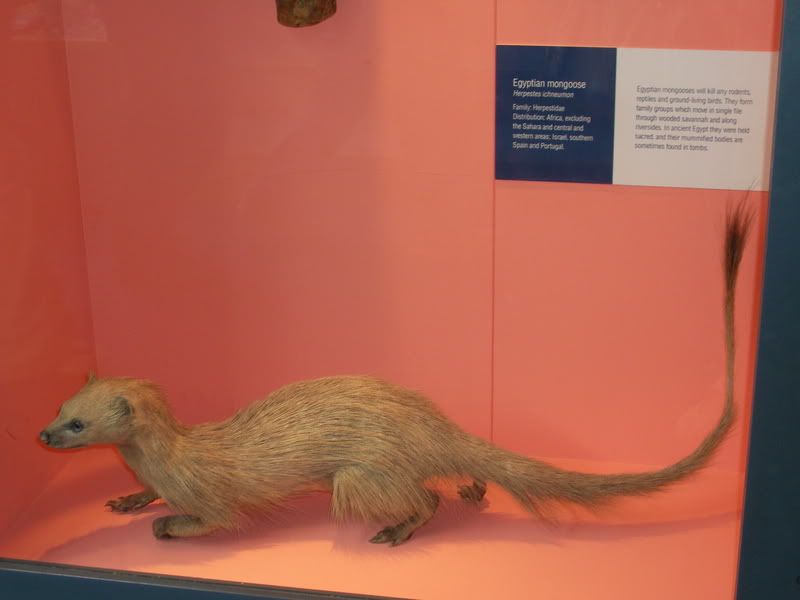
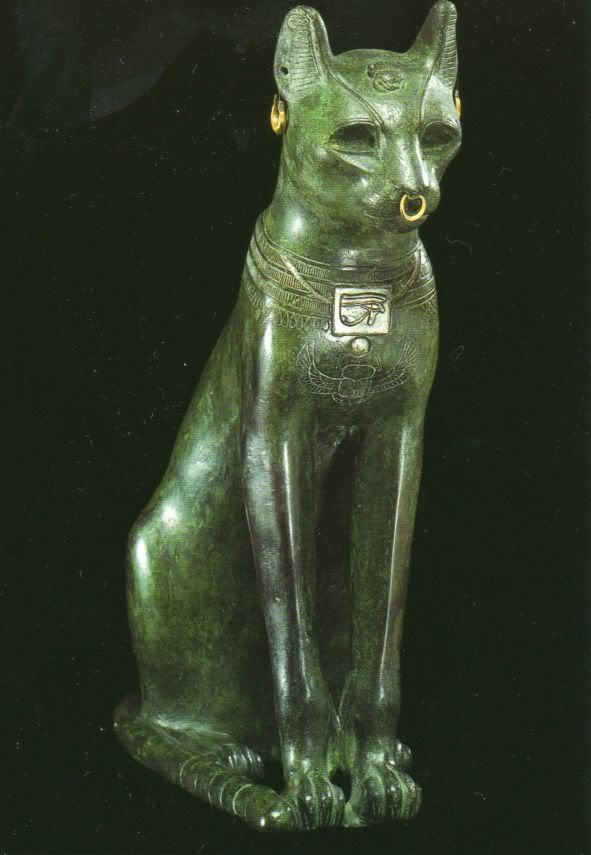
No comments:
Post a Comment